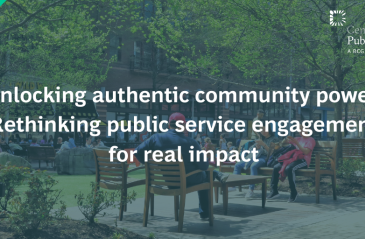
The power of storytelling in climate leadership

When it comes to making progress on the issues, party affiliation matters little
Share articleWe have a different DNA in our culture – the public and private sectors work with each other
Share articleWhen you communicate and try to build consensus, the chances of success are more visible
Share articleWe put our vision for government into practice through learning partner projects that align with our values and help reimagine government so that it works for everyone.
Let's face it, North America's Pacific coastline does not lack for impressive cities. Vancouver, San Francisco and Los Angeles are just a few of the many shimmering examples of liveability that overlook the ocean. But while these cities share a magnetic allure that attracts millions of people from near and far, for many others the search for a place to call home involves heading further south, to the city of San Diego.
Located just 20 miles from the Mexican border, San Diego has been led since 2014 by Mayor Kevin Faulconer. To many, it must seem like a pretty straightforward job. After all, the city enjoys an array of advantages that makes it the envy of its peers: a thriving tourism industry, world-class biotechnology firms, a bustling downtown, 70 miles of beaches, and a natural harbour and deepwater port that have made it the home base of much of the United States Navy Pacific Carrier Fleet. And that's not even counting an average 146 sunny days a year.
Faulconer, though, is not about to rest on these laurels. "You have to start from the perspective that change is inevitable," he says. "You have to adapt - and adapt quickly - or get left behind."
Mayor Faulconer is that rare breed - a senior elected Republican in what is one of the most Democratic states in the country. Faulconer, however, is at pains to stress that when it comes to making progress on the issues that people care about, party affiliation matters little.
"It's not about partisanship, it's about getting results," he points out. "It's not about Republican, Democrat or Independent, it's about getting things done. I have found that when you work alongside people and treat them with dignity and respect - even if you disagree on certain issues from time to time - you can usually achieve pretty significant results. For example, I have a majority of Democrats in the city council, but the two budgets that I have proposed since I have been elected have been adopted unanimously. I believe that when you're focusing on things that matter to people - such as improving our streets, keeping our recreation centres open longer for families - then these priorities transcend day-to-day politics."
His comments echo those of Annise Parker, former mayor of Houston and a Democrat in a famously Republican state. He agrees with her assertion that the partisan politics often found within the Beltway is less prevalent at a local level. "Some partisanship does exist - but people at a local level can see the results in their city, or lack thereof," he says. "So from an accountability perspective, you're either delivering services and doing it right - or not. Whoever the mayor is, you have the accountability and the responsibility. My job is to not point fingers as to why something didn't happen - my job is to make it happen and achieve the best results."
Certainly, his emphasis on collaboration, irrespective of party, is reflected in his determination to nurture and advance San Diego's success in attracting innovative industries aplenty to its region - particularly in the fields of biotechnology and biomedical products. The mayor puts this down to a combination of structural factors that have made the city the ideal "laboratory for innovation".
"This is a city where people really do collaborate," he says. "I know that I'm mayor and so I'm biased, but we have a different DNA in our culture - the public and private sectors work with each other and companies will also team up to work together. We have world-class research institutions that are economic engines, and this gives a leg up to attract some of the best people and push the envelope in a city that people love coming to and where there is a great quality of life."
And keen to match actions with words, he created several new posts in his administration - director of innovation policy, chief data officer, director of performance and analytics, and open data program coordinator - to spearhead this plan of activity. "These new roles send a clear message in perception and reality about the importance of growing our innovation economy even further in the future," he says. "This is also partly why I believe our relationship with Mexico is such a strategic advantage. I am always in contact with my friend and partner, Mayor Astiazarán of Tijuana - I'll go down there and he visits here. If you take what we're doing in San Diego and combine what they are doing in Tijuana, we are the largest region of medical device manufacturing on the planet. Sometimes these products will cross the border two or three times before they are finished."
Although Faulconer has only been mayor two-and-a-half years - he was re-elected in June 2016 with 57% of the vote in a city with just 25% Republican registration - he says that since day one he has sought to set the right example in terms of achieving objectives. To illustrate his point, he cites his success in passing an aggressive climate action plan.
"Our goal is to have 100% renewable energy by 2035 and this was unanimously approved by the city council," he says. "This happened because I spent a lot of time with business leaders and environmental leaders to get everyone around the table. In San Diego, our environment helps define who we are - our sunshine, our beaches, our bays - and we want to keep it that way for generations to come. It again shows how if you work with people, focus on what the goal is and don't get caught up in labels then you can usually - not all of the time but most of the time - achieve success."
The example prompts the question as to how other leaders - and future leaders - can be trained in the art of collaboration and bringing disparate voices to the decision-making table. He says that is down - again - to setting the right example. "Actions have to match words," he says. "And you have to spend a lot of time communicating your principles and values and the objectives you're trying to achieve, and then get out there and talk about it. People will disagree - that's inevitable - but I have found that when you communicate and try to build consensus, the opportunities for success are far more visible than when you try and ram something through. Usually those policies don't stand the test of time."
Mayor Faulconer - whose enthusiasm and positivity crackles through his every sentence - is firm in his belief that San Diego's best days lie ahead
"The city is back and open for business," he concludes. "When I was first elected to the city council eight years ago, we were in dire financial straits and on the verge of bankruptcy. We've spent a lot of time and effort - with voters' support - to make some changes that have turned our city around, enabling us to do things like expand library hours and pave more streets than ever before. I love the fact we have the best city in the country, the best spirit and a city government that is back on track. And I love this job!"











